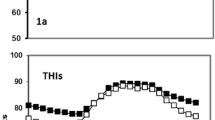Abstract
Past attempts to devise an index of climatic stress are briefly reviewed, and a new “Relative Strain Index (RSI)” is proposed. RSI is the ratio between the evaporative cooling required to compensate for the heat stress, and the maximum evaporative cooling that the animal can provide by physiological means. RSI takes into account the air temperature, vapor pressure, air movement,and radiant heat exchange,as well as the metabolic rate and insulation provided by the animal's coat. Thè index can be used to predict the probable tolerance of animals of types that have been sufficiently well studied. It can also be used to estimate the relative tolerances of animals having different physiological capacities or metabolic rates, but otherwise comparable; and it can be used to predict the relative effectiveness of proposed environmental controls.
Zusammenfassung
Die früheren Versuche, einen Index für den Klima-Sbress auszuarbeiten,werden kurz beschrieben und ein neuer “Relativer Belastungsindex” (relative strain index — RSI) wird vorgeschlagen. RSI ist das Verhältnis zwischen der Verdunstungskälte, die zur Kompensation der Hitzebelastung benötigt wird, und der maximalen Verdunstungskälte des Tieres, die physiologisch möglich ist. RSI berücksichtigt die Lufttemperatur, den Dampfdruck, die Luftbewegung und den Strahlungswärmeaustausch, fernèr die Höhe des Stoffwechsels und die Wärmeisolation durch das Fell. Der Index kann benutzt werden, um die wahrscheinliche Toleranz der Typen von Tieren vorherzusagen, die in ausreichender Weise erforscht worden sind. Er kann ebenfalls dazu verwendet werden, die relativen Toleranzen von Tieren abzuschätzen,die verschiedene physiologische Fähigkeiten oder Stoffwechselraten haben,aber im übrigen vergleichbar sind. Schliesslich kann er bei der Vorhersage der relativen Wirksamkeit der beabsichtigten Kontrollen des Umweltmilieus benutzt werden.
Resume
Les essais antérieurs d'élaboration d'un Indice de Contrainte Thermique sont brièvement décrits et un indice nouveau, appelé “Indice de Charge Relative” (relative strain index = RSI) est proposé. Cet indice est le quotient de la déperdition calorique par évaporation nécessaire en vue de compenser la charge thermique,sur la déperdition calorique maxima par évaporation physiologiquement réalisable par un animal. Cet indice tient compte de la température de l'air,de la pression partielle de vapeur d'eau, de la vitesse de l'air et des échanges par rayonnement thermique,ainsi que de la production de chaleur métabolique et de l'isolement calorique par le pelage. L'index peut être utilisé pour prédire la tolérance probable à la chaleur, d'espèces animales dont les modalités de thermorégulation sont déjà suffisamment bien connues. Il peut être utilisé en outre pour évaluer la tolérance relative d'animaux différant par leurs niveaux métaboliques ou par leurs capacités physiologiques; il peut enfin être utilisé pour prédire l'efficacité relative de divers moyens d'agir sur les conditions thermiques ambiantes.
Similar content being viewed by others
References
BARRADA, M.S. (1957): Responses of dairy cattle to hot environments with special emphasis on respiratory reactions. Ph. D. Thesis, Johns Hopkins Univ., Baltimore.
BARRADA, M.S. and EL-ITRIBY, A.A. (1964): Significance of field and experimental studies on domestic animals. UNESCO Arid Zone Research, 24: 249–258.
BELDING, H.S. and HATCH, T.F. (1955): Index for evaluating heat stress in terms of resulting physiological strains.Heat., Piping,Air-Condit., 27: 129–136.
BENEZRA, M.V. (1954): A new index for measuring the adaptability of cattle to tropical conditions. J.Anim.Sci., 13: 1015.
BURTON, A.C. (1944): An analysis of the physiological effects of clothing in hot atmospheres. Rpt.Aviation Med.Res.Assoc. Committee, C2754, SPC186.
BURTON, A.C. and EDHOLM, O.G. (1955): Man in cold environment. Williams & Wilkins, Baltimore.
GASTAMBIDE, C.A., HENNING, W.L. and MILLER, R.C. (1952):The effects of environmental temperature and relative humidity on the acclimatization of cattle in the tropics. J.Anim.Sci., 11: 50–59.
LEE, D.H.K. (1953): Manual of field studies on the heat tolerance of domestic animals. FAO Dev. Paper 38 (Agric). Food and Agriculture Organiz. of U.N., Rome.
LEE, D.H.K. and HENSCHEL, A. (1963): Evaluation of thermal environment in shelters. Public Health Service, Division of Occupational Health, TR-8.
LEE, D.H.K. and HENSCHEL, A. (1964): How good are our criteria for evaluating thermal stress? Air Engineering (in press).
RHOAD, A.C. (1940): The Iberia heat tolerance test. Trop.Agric., 21:162–164.
ROBINSON, S., TURRELL, E.S. and GERKING, S.D. (1945): Physiologically equivalent conditions of air temperature and humidity.Amer.J.Physiol., 143: 21–32.
SEATH, D.M. and MILLER, G.D. (1947): Health tolerance comparison between Jersey and Holstein cows. J.Anim.Sci., 6: 24–34.
Author information
Authors and Affiliations
Additional information
Parts of this paper were presented during the Third International Biometeorological Congress,Pau,France, 1–7 September 1963.
Rights and permissions
About this article
Cite this article
Lee, D.H.K. Climatic stress indices for domestic animals. Int J Biometeorol 9, 29–35 (1965). https://doi.org/10.1007/BF02187306
Received:
Issue Date:
DOI: https://doi.org/10.1007/BF02187306



